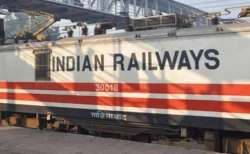Railways' 100-day plan: Cut travel time on Delhi-Howrah, Delhi-Mumbai routes
In a bid to reduce travel time, the Indian Railways, under its 100-day action plan, envisages reducing the travel time on the Delhi-Mumbai and Delhi-Howrah routes at an investment of over Rs 13,500 crore, officials said.

In a bid to reduce travel time, the Indian Railways, under its 100-day action plan, envisages reducing the travel time on the Delhi-Mumbai and Delhi-Howrah routes at an investment of over Rs 13,500 crore, officials said.
This is one of the 11 proposals prepared by the Railways in its 100-day plan, with instructions to initiate immediate action to implement them by August 31.
A senior Railway Ministry official told IANS: "In a proposal approved by Railway Minister Piyush Goyal, the Railways plans to increase the train speed to 160 kmh on the busy routes of Delhi-Mumbai and Delhi-Howrah in the next four years.
"By increasing the speeds on these busiest rail routes, the travel time between Delhi-Howrah and Delhi-Mumbai will be reduced to 12 hours and 10 hours, respectively, as compared to the current 17 hours and 15.5 hours, the official said.
Currently the maximum speed on these routes, which account for 30 per cent of passenger and 20 per cent of freight traffic, is 130 kmh.
The official said the proposal envisages that in the next 100 days, approval should be obtained for this project and the proposal is being sent to the Cabinet Committee for Economic Affairs (CCEA).
The estimated cost to upgrade the speed on the 1,525-km New Delhi-Howrah route will be Rs 6,684 crore and on the 1,483-km New Delhi-Mumbai route will be Rs 6,806 crore, and the entire project is proposed to be implemented within four years from the date of approval, according to the official.
The official said that this is one of the 11 proposals prepared by the railways in its 100-day plan, with instructions to initiate immediate action to implement them by August 31. The official said that under this plan, it may also consider giving premium trains including Rajdhanis and Shatabdis to private players.
Also two trains, covering important tourist destinations or connecting major cities on less congested routes, may be allotted to Indian Railways Catering and Tourism Corporation (IRCTC) on an experimental basis, the official said.
The Request for Proposal (RFP) and a Request for Quote (RFQ) could be issued within the next 100 days, the official said.
The official, however, added that before engaging private operators, the Indian Railways will consult the trade unions. Besides increasing the speeds on these routes, the other plans for the national transporter to be initiated within the next 100 days include the Railways' earlier proposal of handing over certain low-congestion routes to private players and corporatization of production units of rolling stocks.
The railways currently has seven production units (PUs) -- Chittranjan Locomotive Works, Integral Coach Factory, Deisel Locomotive Works, Deisel Modernisation Works, Wheel and Axle Plant, Rail Coach Factory and Modern Coach Factory.
The document proposes to hive off PUs including associated workshops into government owned new entity 'Indian Railways Rolling Stock Company' under the railway ministry and drive technology partnership and modernisation. It proposes that each PU with a CEO will function as an individual profit centre, reporting to the Board or the CMD of the new entity.
The 100-day agenda document also proposed that within the next 100 days, Cabinet approval needs to be obtained for digital corridor for railways with provision of 10 MHz spectrum in 700 MHz frequency band for railways which would enable it to increase trains' carrying capacity due to increased speed potential, improved operation during fog and improved security.
The document also focuses to start work on the pilot projects for advanced signalling system for safety and higher throughput. The official said the advanced signalling system will enhance safety by ensuring that technological aid to the loco pilot is provided to eliminate or considerably reduce accidents due to overshooting of signals and overspeeding.
He said that it will also help in increasing the line capacity on the railway network by 46 to 48 per cent on absolute block system and will also help in improving the punctuality of trains by providing information to the loco pilots of the signal in advance, even in adverse conditions like fog or sharp curves and tunnels.
The 100-day agenda documents also talks about providing Wi-Fi internet connection at all 6,485 railway stations including 4,882 balance stations in the next 100 days, to obtain approval for elimination by 2023 of 2,568 level crossings on golden quadrilateral diagonals with assured 100 per cent funding of Rs 50,000 crore from the government, redevelopment of 50 railways stations and restructuring of railway board and technological revamp.
ALSO READ: Facing favouritism charges, railways introduces fresh tender system for Train 18
ALSO READ: Railway Ministry studying profiles of officials under anti-corruption drive: Piyush Goyal